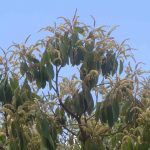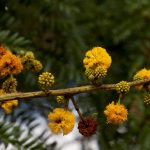TREE LIFE
June 1995
A red dot on your Tree Life is a reminder that we have not yet received your $40 subs for 1995/96, and this will be the last Tree Life we can send you. Please!
MASHONALAND CALENDAR
Saturday 3rd June: Botanic Garden Walk at 1045 for 1100 hours. We will meet Tom I the public car park of the Gardens where there will be someone to guard the cars. Tom will continue with the popular subject – Acacias.
Sunday 18th June: We are happy to be joining the Cycad and Palm Society on their trip to see the famous Raffia palms, Raphia farinifera, on Archie and Molly Greenshield’s farm M’wari, in the Palm Block. It is more than 9 years since the Tree Society visited these palms and it will be very interesting to see if there has been much change in that time.
Saturday 24th June: On Mark’s Botanical Walk we will look at the open ground near his house, so we will meet at Mark’s house at 1500 hours as usual.
Saturday 1st July: Botanic Garden Walk.
MATABELAND CALENDAR
Sunday 4th June: Below Lumani Falls. An all daytrip of approximately 200 km. Depart promptly from Girl’s College at 0830 hours.
June 16, 17, 18. Ivory Safaris at Dett. $350 p.p.p.w/e, Clem, Margaret and Ian will be the organizers.
Extra: On the 2nd Sunday of each month starting from 12th June, at 1945 for 2000 hours David Attenborough’s “The Private Life of Plants”. 6 episodes over the next six months. The first episode will be shown at Clem von Vliet’s home and thereafter at Girls’ College.
Benedicta Graves write from Raffingora that “Frogs of Zimbabwe” is a museum publication and there is no ISBN number. If interested write to the Direcor, Musio Regionale, di Scienze Natruale, Via G. Giolitte, 36. 10123 Torino, Italy. This information comes from Moira Fitzpatrick of the Bulawayo Museum.
BOTANIC GARDEN WALK 2ND May 1995
Acacias being part of the Mimosoideae genus are generally found with bipinnate leaves, thorns or prickles, produce pods with the indigenous species Tom showed us how they can be placed into three groups:
Those having spines and hooked thorns
Hooked thorns only
Spines only
Some other features to look at are the size of the pinna compared to the entire leaf and the density of the individual leaflets as well. The density of the individual flowers is often so great that they appear as pom pomson trees with straight spines and cylindric blooms on those with curved hooks. Each individual flower although difficult to see contains floral parts in fives with small petals and the long stamens making up the visible part of the flower. The colours are usually white or yellow.
Starting with hooks and spines we looked at Acacia tortillis, a common resident of the lowveld and up to altitudes of 1200 meters where it is an invader of disturbed land. Reasonably easy to recognize by the scattered long white spines and paired hooked thorns. The leaves are closely packed with many tiny leaflets and a mature tree tends to have a somewhat umbrella like shape. The seed pod is contorted, hence the specific name and is needed to separate the two sub-species. Continuing on to hooked thorns, the Monkey Thorn, Acacia galpiii, is another common lowveld species with scattered occurrence in the Highveld, particularly on anthills and watercourses. Generally a large fast growing tree with rough bark, paired hook thorns and big leaves with many pinna. The large flat pod has a distinctive “neck” near the end and the flower is a white cylindrical shape. Acacia senegal, source of the well known confectionary additive “gum Arabica” has triple hook thorns and has two varieties, 1) var leiorhachis whwich is a slender erect tree with an attractive pale peeling bark similar to some of the Commiphora species and 2) var rostratum, a shrub with a featureless pale grey bark. The well known Knob Thorn, Acacia nigrescens, has the largest leaflets with generally 2 leaflets per pinna and three pairs of pinnae forming each leaf. The thorns are paired hooks which become massive on mature trees. Appearing before the leaves the blooms are white and are produced in a cylindric shape. Acacia mellifera subs. detinens differs from the above guides it produces pom pom white flowers instead of the expected cylindrical bloom. The appearance of these thicket forming trees is that of a dense rounded crown with the leaf similar but smaller compared to Acacia nigrescens and short straw coloured flat pods are produced.
In the western part of the country two similar species occur and they are Acacia erubescens and Acacia fleckii. The latter can be a large tree or shrub and has densely packed leaflets on a rounded leaf with a short petiole. Acacia erubescens also called the Blue Thorn differs from the above by the slightly recurved leaves having about half the number of leaflets per pinnae and a longer petiole. Here the ratio of the pinnae to leaf length is about half. Paired thorns are found below the nodes and a further identifying feature is the pale peeling bark. Acacia hereroensis, another species from the drier western districts reaches its maximum size in Botswana where it can exceed 15 meters but is most often a spreading shrub or small tree. A rough bark varying from brown to grey tends to have flaky pieces and a long thin pod with “necks” between the seeds is another feature.
The largest leaf can be found on Acacia polyacantha, where despite the large number of leaflets the tree has a feathery appearance and the hooks are often absent on mature specimens. The bark is a pale yellow on young trees changing to a grey on maturity. The pale flat pods have a thin rim around the edges. In this country the subspecies is subs. camphylacantha and these trees are well known invaders of degraded Brachystegia woodland.
Thank you Tom for once again taking us around and look forward to some more on Acacias in our next Botanic Garden walk.
-Andy MacNaughtan
TREE TEASERS FROM MOZAMBIQUE
For those who enjoy the challenge of solving puzzles, here are a few from Mozambique contained in a letter written by Father Andre Fernandes to Father Pedro da Fonseca on 16 January 1563. (This is not a typo, this is the date recorded). There are no prizes for guessing what the trees might have been, but I am sure Tree Life would be prepared to provide space for readers’ opinions.
“……… and I do aver that what I say is no lie but rather what I saw or what I was told b persons of credit …In the land….. between Cape Corientes and Cape of Good Hope there grows a large kind of tree, almost like a chestnut in the shape of the leaves thereof, it produces a small prickly fruit containing from three to five bean like pods, only what is white in beans is red in the aforesaid fruit, being a very thin skin between it and the stone; this latter is not very hard, being rather dry, and when green it is easily cracked with the teeth without applying much force. It has a little white pulp which, if kept in the mount, is soon melted by the moisture thereof, both the skin and the pulp, the taste being like green hazel nuts like the ones I picked from the trees in England and in the Alps; on sucking, there remain the stones which after being crushed and boiled yield a bitter oil, thick like butter in Winter, with which the people anoint their bodies and cure almost all their illnesses; also the Portuguese who go there have experience of it as possessing medicinal properties for wounds and running sores and other such like ailments. The people call celica both the tree and its fruit.”
“There is another large tree the leaves whereof are like those of a pear tree, though less ruddy; of a man rubs the itch with the crushed and boiled bark together with the water therein it was boiled, he will be healed.”
“There is another small tree the branches whereof being crushed and the powder being put in a piece of cloth, and the eyes being washed with it after moistening with water, eye diseases are cured. It know not the name of these trees.”
“There is yet another which, according to the people, the wood thereof being crushed and drunk, cures the ague, and others still the bark and leaves of which, after having been crushed or cut and boiled with the pot tightly lidded, will likewise cure the ague; however, as the people when they use these potions – excepting the three above mentioned, do so with superstitious practices, I will not guarantee their virtues.”
“There are also in the land many mirabulanos, of which trees there are males and females, the males yielding no fruit whatsoever, and these trees being generally tall with but little foliage, whereas the female trees have much foliage, the branches hanging down to the ground. The fruits thereof, when full grown, but before ripening, are bitter and flavoury; the Portuguese eat them boiled with meat, and so do I, the flavour being very good, it being said that this fruit is particularly useful in abating and purging the cholera. When ripe, they become pink in colour, the taste being very good and bitter sweet. The people use them for making wine. Their season is from mid-January to mid-March, as for olive trees.”
“There also many fruits wherewith they make wine, both the one from them and from the mirabulanos, going quickly to the head.”
“There are many trees which every night bloom into full grown flowers as if they were several days old; their smell is very special, and either because of the coolness of the morning or by effect of the sun, before and after it has come out and even in places not exposed to the sunlight, these flowers, before blooming forth, grow little by little from the pod whereon they stand, until they fall down, though not because they are wilted. There are trees like these in India.”
“There are others still of large size which look like jujube apple trees, and while small the bark thereof serves to make tough thongs wherewith the people bind all kinds of houses and so forth, after having grown somewhat the same bark is more workable and they use if for making the clothing they wear and bedspreads with which they cover themselves, and very good they are, I myself, when among them, having used one for many days, for the former purpose they wrench the bark away by hand after the branches have been chopped off, and for the latter they cut branches of a man’s thickness more or less, these being bent to the ground, using hoe like wooden tools they strike above and around until the bark and the trunk are reached, and so, little by little, they strip the tree striking the outside bark until it is broken, there remaining the inside sound tissue; though not very well woven, by joining two or more together, they make bedcovers, as I say, being sewn together with threads taken from the smaller branches. When they are old, the bark of these trees is so tough that with it they make vessels of large size with capacity for a moio of what, being in addition sewn with certain kinds of osier. And when this tree begins to grow new foliage, which it sheds every year, there breeds on it a kind of worm the size of a man’s thumb, rather like silk works which taken in the morning before having fed upon the new leaves and then boiled dry the people find so savoury that on questioning one of them touching this he told me that the taste is like chicken; in those few days the leaves are still tender and there are many such worms, this tree being called imze.”
“Other trees are to be found there which they call gourd trees because the fruit thereof looks like a gourd, though harder, and with it they draw water from their wells; the pulp is very bitter, and they eat it, these trees having very little foliage and being of great thickness; I myself saw one being measured with a sword of more or less five spans, and the measure thereof was some fourteen or fifteen such swords, some other trees being even thicker. They say that elephants shun this kind of tree because it is soft; it sometimes happens that they stick their tusks into it and cannot pull them out again, and thus the elephant’s tusks are broken, wherefore the people are wont to seek shelter near these trees when running away from elephants, men of experience avoiding other trees which, being weak, the elephants break until they kill their pursuers. This I was told in that land by Portuguese who said this is what they had heard.”
There are still other trees, also to be found in India, the roots thereof growing above the branches in addition to the roots from which they rise, and when they begin to sprout, and thereafter too, they acquire the same colour, flavour and softness as if they had grown under the earth. These trees are very large and cast a wide shade.”
“It is said that in Molucca there is a tree of fair size which, if a man lies down in its shade on the east side, he falls sick and feels unwell, whereas if he does so on the west side he will feel well. So much for trees.”
These extracts were taken from the Documents on the Portuguese in Mozambique and Central Africa, Volume VIII.
So, did anyone identify the marula? Did anyone fail to identify the baobab? And what about the others?
-Lyn Mullin
MAZURI RANCH, KWEKWE DISTRICT; 28 APRIL TO 1 MAY 1995
Mazuri Ranch lies on the eastern side of the Great Dyke, here called the Mashaba Mountains) some 55 km E of Kekwe and about 25 km S of Ngezi Recreational Park. We approached it via Kwekwe, turning off there on the tarred road to Mvuma. At the Sebakwe Club we took the gravel road towards Ngezi, over some very bad corrugations. On the way we met Eleanor Lowe the farm owner, who directed us to our campsite which was in woodland close to a small dam.
Near to the camp was an apparently friendly sable, which came confidently up to us and allowed our children to touch it through the windows of the car. However, it then started to knock its horns against the vehicle in a threatening manner, so we moved rapidly off. We were later told that it had been hand reared and had no near of man. Indeed, we were advised to be very wary of it.
It was not until after dark that the next party arrived, Andy, Maureen and Rose, slightly shaken by the corrugations but ready to tackle pitching a tent in the dark.
We found that a lot of the ranch consists of rather dry woodland, similar to Ngezi. The altitude ranges from 1260 to 1300 meters, although it reaches 1372 m on the top of Chombe and over 1400 meters on the Dyke. Commonest species seen were two Acacias, karroo and nilotica, Brachystegia boehmii, three Combretums, apiculatum, hereroense and molle, Diplorhynchus condylocarpon and Julbernardia. Soils were poor and rocky with a limited grass cover. There were frequent patches of mopane, these with an almost total absence of ground cover. Although there were a number of vleis, Eleanor told us that those had dried up a lot recently and indeed seemed large to consist of coarse grasses.
On the first morning, Saturday, we drove to the main house and then climbed up a steep sided, flat topped hill, Chombe, behind the house. This is an isolated hill away from the Dyke, which we thought might have had potential, but actually from a tree point of view was rather disappointing. Most noteworthy was a Commiphora mossambicensis on the top. By the afternoon, the rest of the group had arrived, Bob and Liz Manser and Richard and Jean Williams, and we walked in the woodland below the dam wall.
Most remarkable here were the enormous Acacia goetzei spp. goetzei which seemed to be on every anthill and which had what appeared to be large round deformities on the upper trunk and branches.
On Sunday, Gordon Cormack, a hunter, took us up to the Dyke. Before that, not very far from the farmhouse, Gordon showed us some young specimens of Faidherbia albida which had been introduced from the Zambezi Valley and were growing on the site of the old boma.
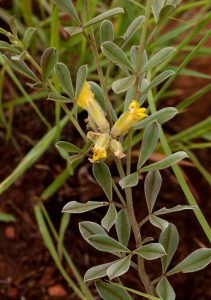
Pearsonia metallifera. Photo: Bart Wursten. Source: Flora of Zimbabwe
As we drove towards the Dyke, we saw Acacia chariessa in flower and fruit and Euclea crispa ssp. linearis, both suggesting that we were on interesting soils and that Dyke specials could be expected. And indeed there were, the spiny knee high Baleria molensis, eventually found with white flowers, the white leaves of Dicoma niccolifera and the yellow flowers and silvery foliage of Pearsonia metallifera to mention a few. We also found a herbaceous Rutaceae, Thamnosma rhodesia which has strange club like fruits.
In the area there was a rhino with a baby, but although Gordon showed us evidence of its past presence, we did not actually come across it.
For lunch we left Mazuri and drove north to the Munyati River. There we picnicked in the sandy river bed and walked up to a remarkable pot hole filled gorge. This is an overflow channel for the river, which effectively divides into two. The astonishing potholes and bare rocks have an interesting rocky flora at the edge, which includes gigantic Aloe excela, the spiny stems of Euphorbia griseola, Ficus abutilifolia and Commiphora marlothii. Around the potholes and in the damp sand were a number of herbs, amongst which were the yellow flowered Ludwigia octovalvis and a remarkable prostrate pea with red flowers and 2 leaflets per leaf, Indigofera flavicans.
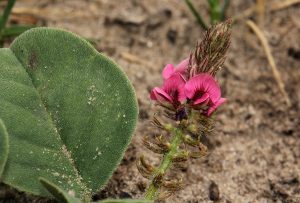
Indigofera flavicans. Photo: Mark Hyde. Source: Flora of Zimbabwe
On the last day we left via Mvuma, taking an interesting back route through Central Estates and stopping for lunch by the Sebakwe River.
Our thanks go to Eleanor, Gordon and rob for helping to make the visit such a pleasant and interesting one.
-Mark Hyde
HALLERIA LUCIDA
A SUCCESSFUL SMALL TREE FOR South African gardens by Rodney Saunders, Veld and Flora, September 1988, Vol. 74, No. 3
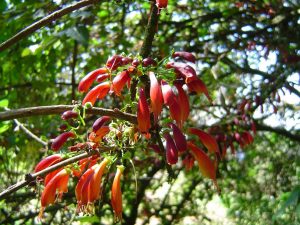
Halleria lucida. Photo: Bart Wursten. Source: Flora of Zimbabwe
Whenever I am asked to recommend a tree that is evergreen, fast growing, drought resistant, hardy to frost, has sweet smelling flowers and finally, berries that attract birds, I am tempted to suggest privet, for it is the only tree that I know that fits all these specifications. However, there is one indigenous tree, lacking the vulgarity of privet, that approaches the same east of cultivation, and that is Halleria lucida, a member of the snap dragon family, Scrophulariaceae, commonly known as ‘Notsung’ tree, fuchsia or white olive.
The tree gets its generic name from an eighteenth century European botanist, Allbrecht von Haller, and the specific name ‘lucida’, meaning bright, shiny and clear, refers to the leaves. The flowers resemble those of the cultivated fuchsia and hence the common name, tree fuchsia. The name ‘Notsung’ is believed to be of Hottentot origin, although Marloth states that the name was applied to the tree by early German foresters, and is a corruption of the German word ‘Nutzung’ meaning usufruct, as the wood of Halleria lucida was free and no permit was required to cut it.
Distribution. Halleria lucida is widely distributed throughout Africa, from the Sudan in the north to the Cape Peninsula in the south. Within South Africa it is found in all four provinces in a wide variety of habitats ranging from forests and forest margins, to exposed slopes, grassland and karroid scrub. It is this adaptability that makes it an ideal subject for South African gardens.
Description. Halleria lucida is an evergreen shrub or tree, growing to about 2 or 3 m in height, although it can occasionally reach 12 m. The branches are fairly stiff and erect, although the terminal branchlets may be arching and pendulous, particularly when the tree is grown under fertile conditions with plenty of water. The leaves are opposite and are clear, shiny and bright green. The tubular orange to red flowers, occurring from late autumn to spring, are most attractive, but unfortunately are borne on mature wood, frequently on the main trunk itself, so are generally obscured by the foliage. The flowers are followed by succulent berries which become blackish when ripe. Judging from reports the berries are edible, but not palatable and are said to have a sickly sweet taste which dries the mouth.
Use in the garden. This tree is an ideal screen plant and with its graceful arching habit, forms an excellent backdrop or foil for most garden ornamentals. The roots are not invasive or aggressive, so smaller shade loving plants such as clivia or knowltonia can be cultivated beneath it. It is ideal for small gardens and does well as a specimen plant, on a patio, or as foundation planting around buildings. Preliminary trials have suggested that it may well be suited to container cultivation.
As a means of bringing birds back into the garden, this tree may well be unequalled. The flowers have a plentiful supply of nectar and several species of sunbirds are attracted to the tree throughout the flowering period. The succulent berries ripen from August onwards, at a time when very little else in the garden is in fruit and this attracts the fruit eaters. White eyes can be found in the tree throughout the year, either feeding or seeking shelter. In fact, Halleria lucida forms a bird community centre in the garden and deserves wider recognition amongst gardeners.
Acknowledged with thanks to the author and publisher.
ANDREW MACNAUGHTAN CHAIRMAN


